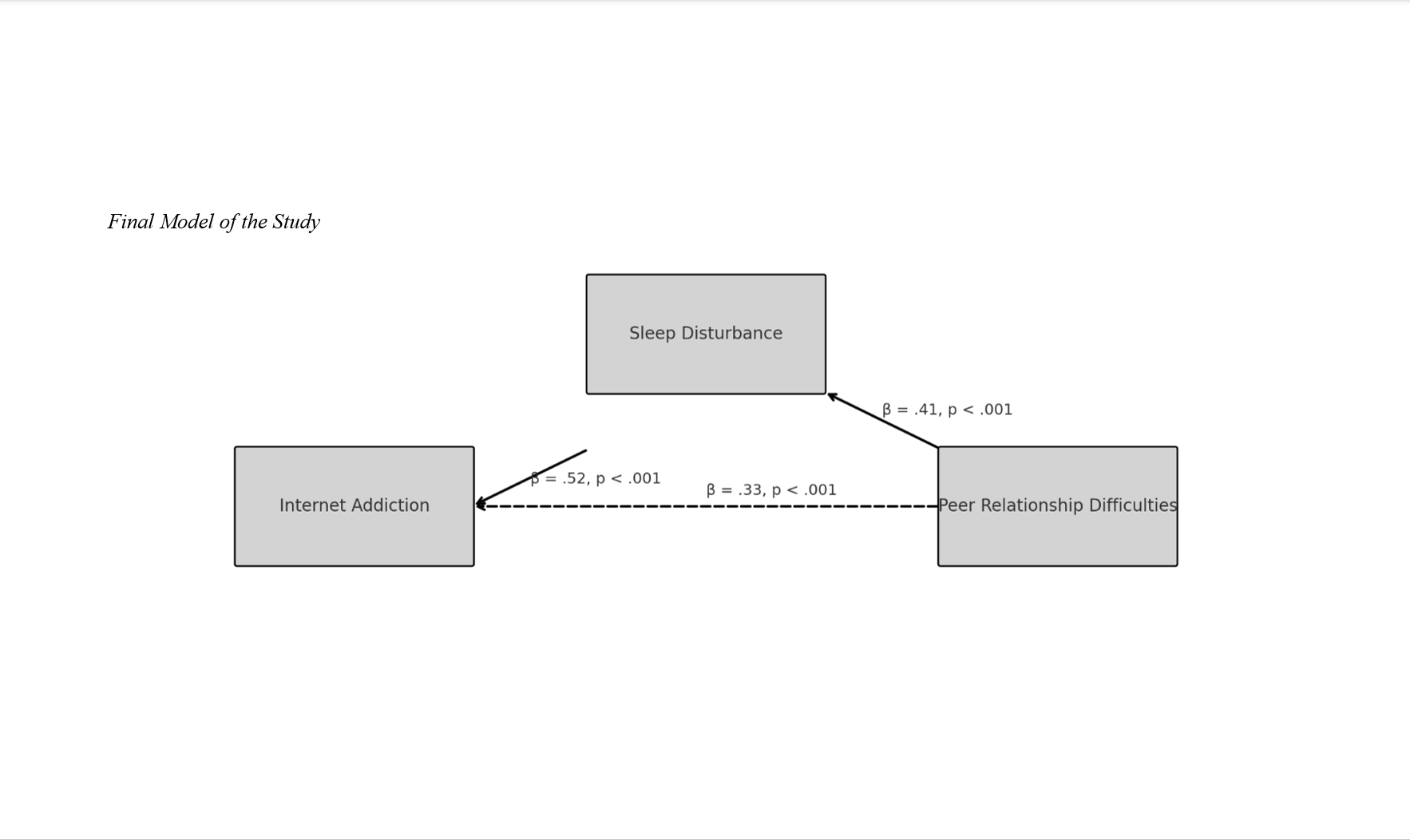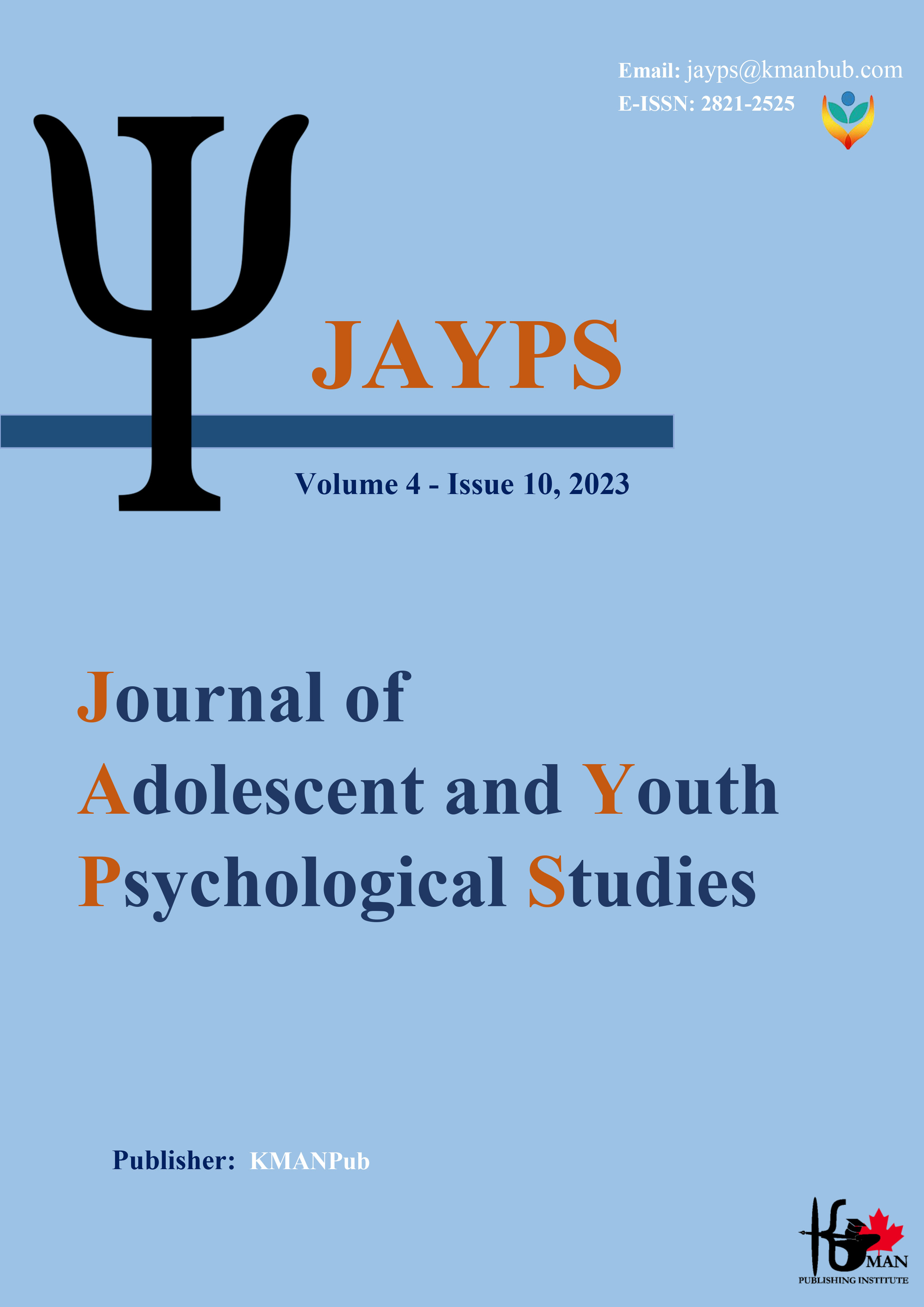Internet Addiction and Peer Relationship Difficulties: The Mediating Role of Sleep Disturbance
Keywords:
Internet addiction, peer relationship difficulties, sleep disturbanceAbstract
Objective: This study aimed to investigate the mediating role of sleep disturbance in the relationship between internet addiction and peer relationship difficulties among adolescents.
Methods and Materials: A descriptive correlational design was employed, and the study was conducted with 405 adolescents from Colombia, selected based on the Morgan and Krejcie sampling table. Participants completed three standardized instruments: the Internet Addiction Test (IAT), the Sleep Disturbance Scale for Children (SDSC), and the Peer Problems subscale of the Strengths and Difficulties Questionnaire (SDQ). Data were analyzed using Pearson correlation coefficients to examine bivariate relationships, and Structural Equation Modeling (SEM) was conducted using AMOS-21 to test the mediating model. The assumptions of normality, linearity, homoscedasticity, and multicollinearity were checked and confirmed.
Findings: Internet addiction was significantly and positively associated with sleep disturbance (r = .52, p < .001) and peer relationship difficulties (r = .43, p < .001). Sleep disturbance also had a significant positive correlation with peer relationship difficulties (r = .47, p < .001). The SEM analysis confirmed an acceptable model fit (χ²(48) = 108.53, χ²/df = 2.26, GFI = .95, CFI = .96, RMSEA = .055). Direct effects were significant from internet addiction to sleep disturbance (β = .52, p < .001), sleep disturbance to peer difficulties (β = .41, p < .001), and internet addiction to peer difficulties (β = .33, p < .001). An indirect effect from internet addiction to peer difficulties via sleep disturbance was also significant (β = .21, p < .001), supporting partial mediation.
Conclusion: The findings demonstrate that sleep disturbance plays a significant mediating role in the link between internet addiction and peer relationship difficulties. These results highlight the need for targeted interventions that address both digital behavior and sleep hygiene to improve adolescents’ social well-being.
Downloads
References
Bishop, H. K. D., Claxton, S. E., & Manfred, H. M. v. D. (2018). The Peer Relationships of Those Who Have Experienced Adoption or Foster Care: A Meta‐Analysis. Journal of Research on Adolescence, 29(4), 796-813. https://doi.org/10.1111/jora.12421
Boivin, M., Brendgen, M., Vitaro, F., Forget‐Dubois, N., Feng, B., Tremblay, R. E., & Dionne, G. (2013). Evidence of Gene–environment Correlation for Peer Difficulties: Disruptive Behaviors Predict Early Peer Relation Difficulties in School Through Genetic Effects. Development and Psychopathology, 25(1), 79-92. https://doi.org/10.1017/s0954579412000910
Buissonnière-Ariza, V. L., Hart, D. L., Schneider, S. C., McBride, N. M., Cepeda, S. L., Haney, B., Tauriello, S., Glenn, S., Ung, D., Huszár, P., Tetreault, L. L., Petti, E. A., Winesett, S. P., & Storch, E. A. (2018). Quality and Correlates of Peer Relationships in Youths With Chronic Pain. Child Psychiatry & Human Development, 49(6), 865-874. https://doi.org/10.1007/s10578-018-0802-z
Chen, B. B., & Santo, J. B. (2015). The Relationships Between Shyness and Unsociability and Peer Difficulties. International Journal of Behavioral Development, 40(4), 346-358. https://doi.org/10.1177/0165025415587726
Chu, X., Ji, S., Wang, X., Yu, J., Chen, Y., & Lei, L. (2021). Peer Phubbing and Social Networking Site Addiction: The Mediating Role of Social Anxiety and the Moderating Role of Family Financial Difficulty. Frontiers in psychology, 12. https://doi.org/10.3389/fpsyg.2021.670065
Forrest, C. L., Gibson, J. L., Halligan, S. L., & Clair, M. S. (2018). A Longitudinal Analysis of Early Language Difficulty and Peer Problems on Later Emotional Difficulties in Adolescence: Evidence From the Millennium Cohort Study. Autism & Developmental Language Impairments, 3. https://doi.org/10.1177/2396941518795392
García, I. S., Valera-Pozo, M., Sanchez-Azanza, V. A., Adrover‐Roig, D., & Aguilar‐Mediavilla, E. (2021). Associations Between Self, Peer, and Teacher Reports of Victimization and Social Skills in School in Children With Language Disorders. Frontiers in psychology, 12. https://doi.org/10.3389/fpsyg.2021.718110
Gultom, M. J., & Wibowo, D. H. (2025). Peer Social Support and Career Decision-Making in Adolescents From Broken Homes: A Career Counseling Perspective. Jurnal Bimbingan dan Konseling Terapan, 9(1), 47-60. https://doi.org/10.30598/bkt.v9i1.17109
Healy, K. L. (2017). Children With Peer Relationship Difficulties. 97-106. https://doi.org/10.1093/med-psych/9780190629069.003.0007
Khpalwak, A. T., & Hamidi, M. S. (2024). Relationship Between Social Media Use and Sleep Disturbance Among Adults in Afghanistan. American Journal of Medical Science and Innovation, 3(1), 27-34. https://doi.org/10.54536/ajmsi.v3i1.2418
Li, J., Gao, Y., Liu, J., Liu, X., & Wang, H. (2023). Impacts of Difficulties With Emotion Regulation on the Longitudinal Relationship Between Peer Victimization and Changes in Adolescent Nonsuicidal Self‐injury. Journal of adolescence, 96(2), 350-359. https://doi.org/10.1002/jad.12279
Löper, M. F., & Hellmich, F. (2024). Teachers’ Role Model Behavior and the Quality of the Student–teacher Relationship as Prerequisites for Students’ Attitudes Toward Peers With Learning Difficulties. Frontiers in Education, 9. https://doi.org/10.3389/feduc.2024.1400471
Lukas, L., Buhl, C., Schulte‐Körne, G., & Sfärlea, A. (2022). Family, Friends, and Feelings: The Role of Relationships to Parents and Peers and Alexithymia in Adolescents With Anorexia Nervosa. Journal of eating disorders, 10(1). https://doi.org/10.1186/s40337-022-00661-3
Manis, J., & Stewart, S. L. (2024). A Snapshot of Peer Relationships in Children and Youth: Pre- Versus During COVID-19. International journal of environmental research and public health, 21(12), 1552. https://doi.org/10.3390/ijerph21121552
Marsus, N. b., Huey, L. S., Saffari, N., & Motevalli, S. (2022). Peer Relationship Difficulties Among Children With Adhd: A Systematic Review. International Journal of Academic Research in Business and Social Sciences, 12(6). https://doi.org/10.6007/ijarbss/v12-i6/13352
Mikami, A. Y., & Normand, S. (2015). The Importance of Social Contextual Factors in Peer Relationships of Children With ADHD. Current Developmental Disorders Reports, 2(1), 30-37. https://doi.org/10.1007/s40474-014-0036-0
O'Hare, D., Eapen, V., Helmes, E., McBain, K., Reece, J., & Grove, R. (2015). Factors Impacting the Quality of Peer Relationships of Youth With Tourette’s Syndrome. BMC psychology, 3(1). https://doi.org/10.1186/s40359-015-0090-3
Özdemir, S. B., Cheah, C. S. L., & Coplan, R. J. (2016). Processes and Conditions Underlying the Link Between Shyness and School Adjustment Among Turkish Children. British Journal of Developmental Psychology, 35(2), 218-236. https://doi.org/10.1111/bjdp.12158
Sarfo, J. O., Gbordzoe, N. I., Commey, V. D., Tawiah, E. D., & Hagan, J. E. (2024). Gender Differences in Anxiety-Induced Sleep Disturbance: A Survey Among in-School Adolescents in the Republic of Benin. Social Sciences, 13(12), 655. https://doi.org/10.3390/socsci13120655
Schoeps, K., Mónaco, E., Cotolí, A., & Montoya‐Castilla, I. (2020). The Impact of Peer Attachment on Prosocial Behavior, Emotional Difficulties and Conduct Problems in Adolescence: The Mediating Role of Empathy. PLoS One, 15(1), e0227627. https://doi.org/10.1371/journal.pone.0227627
Schoop‐Kasteler, N., & Müller, C. M. (2019). Peer Relationships of Students With Intellectual Disabilities in Special Needs Classrooms – A Systematic Review. Journal of Research in Special Educational Needs, 20(2), 130-145. https://doi.org/10.1111/1471-3802.12471
Siegel, R. S., Freeman, A. J., Greca, A. M. L., & Youngstrom, E. A. (2014). Peer Relationship Difficulties in Adolescents With Bipolar Disorder. Child & Youth Care Forum, 44(3), 355-375. https://doi.org/10.1007/s10566-014-9291-9
Solmaz, S., İnan, M., & Şahi̇n, M. (2025). The Moderating Effects of Physical Activity on Social Anxiety and Sleep Disturbance: Managing Gaming Disorder in Young E-Sports Players. Frontiers in Public Health, 13. https://doi.org/10.3389/fpubh.2025.1544044
Su, S., Pettit, G. S., & Erath, S. A. (2016). Peer relations, parental social coaching, and young adolescent social anxiety. Journal of Applied Developmental Psychology, 42, 89-97. https://doi.org/10.1016/j.appdev.2015.11.007
Szczęśniak, M., Bajkowska, I., Czaprowska, A., & Sileńska, A. (2022). Adolescents’ Self-Esteem and Life Satisfaction: Communication With Peers as a Mediator. International journal of environmental research and public health, 19(7), 3777. https://doi.org/10.3390/ijerph19073777
Wu, J., Wu, X., Tarimo, C. S., Zhao, W., Xia, Q., Xu, X., Wu, C., Feng, H., Miao, Y., Liu, R., & Yang, Y. (2025). Network analysis of Internet addiction and depression among Chinese adolescents. Journal of affective disorders, 378, 119-127. https://doi.org/10.1016/j.jad.2025.02.052
Yu, J. H. (2019). A Case Study on Family Therapy for Child With Difficulty in Forming Peer Relationships. The Journal of Play Therapy, 23(1), 89-104. https://doi.org/10.32821/jpt.23.1.7
Yumru Mentes, H., & Koc, S. (2025). Effects of a nurse-led play-based internet addiction prevention program in early adolescents: A randomized controlled study. Archives of Psychiatric Nursing, 151851. https://doi.org/10.1016/j.apnu.2025.151851

Downloads
Additional Files
Published
Submitted
Revised
Accepted
Issue
Section
License

This work is licensed under a Creative Commons Attribution-NonCommercial 4.0 International License.








